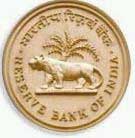Reserve Bank of India has increased cash reserve ratio by 75 bps to 5.75 Percent , the hike would happen in two stages, the first stage of hike of 50 bps will be effective from February 13 and the next 25 bps from February 27. RBI has not touched the the reverse repo rate which is at 3.25percent and repo rate which is at 4.75 percent. CRR hike would suck out Rs 36,000 crore liquidity from the system.

This policy is the first major move to mark the reversal of the easy money policy adopted since October 2008.
The central bank absorbs excess funds from the banking system at the reverse repo rate, which is at 3.25 percent, and lends money to banks at the repo rate, which is 4.75 percent.
RBI projected the GDP growth for financial year 2009-10 at 7.5% from 6% last year. It also said that the inflation would be around 8.5% in March
About CRR, repo rate and reverse-repo rate
A central bank has two sets of tools – quantitative and qualitative – to signal easing or tight money conditions, depending on its policy objective.
While quantitative tools would include imposing cash reserve requirements (CRR) for banks, fixing the repo or reverse-repo rates, the bank rate and prescribing the level of statutory liquidity ratio (SLR) to signal the level of growth in the financial markets, pursuant with its growth objective for the economy.






